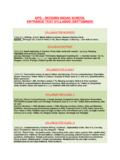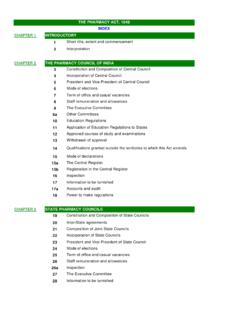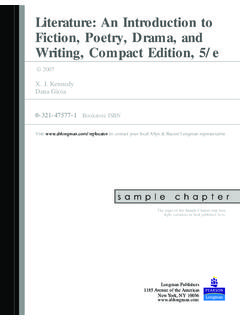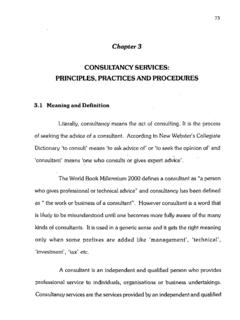Transcription of Introduction and objectives - Law NUJS Kolkata WB …
1 1 COMPARATIVE LAW1 Introduction and objectives : The conception and design of this course are aimed at: (i) acquainting the students with the comparative method in the study of law and (ii) exploring the possibilities of employing that method for the better understanding and reform of our legal system. The course seeks to achieve these goals in three ways. Firstly, it tries to comprehend an understanding of the conceptions, scope and utility of comparative law. Secondly, it gives a bird s eye view of different legal systems in the present day world.
2 Finally, it compares the two most dominant and widespread legal systems, the common law and the civil law systems. For comparison we assume that our own legal system represents the common law while France and Germany represent the civil law. In view of the constraints of time and expertise the course is confined to the following topics. 1. CONCEPTION, EVOLUTION, SCOPE AND UTILITY OF COMPARATIVE LAW: The topic includes different conceptions of comparative law such as a method of study or distinct science of law; descriptive, applied and abstract comparative law; the subject matter and materials for comparison; and the utility of the subject to a legal scholar practical lawyer, legislature and a legal emissary.
3 Readings: 1. Materials supplied for the class ( hereafter Materials) 2. A. Harding & E. Oeruecue (eds), Comparative Law in the 21st Century (Kulwer Academic Publishers, London, Hague, NY, 2002) pp. 1-54 3. Gutteridge, Comparative Law ( Camb. Uni. Press 2nd ed., 1949) Chaps I,II &VI. 1 Course Teacher: Prof.(Dr.) , Vice Chancellor, WBNUJS 2 4. R. Khan & S. Kumar, An Introduction to the Study of Comparative Law ( Tripathi, Bombay for ILI, 1971) Chaps I, II, & III. 5. R. David & Bierley, Major Legal Systems in the World Today ( Stevens & Sons, London, 3rd ed.)
4 , 1985) Introduction . 6. Glendon, Gordon & C. Osakwe, Comparative Legal Traditions ( West Publishing Co., St Paul, 1985) Introduction . 7. , the History of Comparative Law, 45 Harv. L. Rev. 1027 (1932) 8. Menski, Comparative Law in a Global Context ( Platinum, London, 2000) References Paul H. Rubin, The Evolution of Efficient Common Law ( An Elgar Reference Collection, 2007). Andrew Borkowski & Paul du Plesis, Text Book on Roman Law ( Oxford University Press, 2005) Weeramantry, An Invitation to the Law, ( Lawman, 1998) II. MAJOR LEGAL SYSTEMS: The topic examines the need and criteria of classification between different legal systems and the major categories of such systems in the present day world.
5 These categories include the Romano Germanic or civil law and common law as major categories and along with them the socialist, Islamic Hindu, Jewish, far Eastern and African legal systems as not so major categories. Only basic distinctive features of these legal systems shall be examined at this stage leaving the details to subsequent topics. Effort shall be made to locate the position of the Indian legal system in these categories. Readings: 1. Materials. 2. David & Bierley, Introduction 3. Glendon et al, Introduction 4. R. David, English Law and French Law ( Eastern Law House, Calcutta) Chapters I & 2 3 References Werner Menski, Comparative Law in a Global Context Legal System of Asia and Africa ( Cambridge University Press, 2006) H.
6 Patrick Glenn, Legal Traditions of the World Sustainable Diversity in Law ( Oxford University Press, 2000). Peter de Cruz, Comparative Law in a Changing World ( Cavendish Publishing Limited, 1999) Wendy Dongier & Brian K. Smith, The Laws of Manu ( Penguin, 1991) III. STRUCTURE AND SOURCES OF LAW IN CIVIL AND COMMON LAW SYSTEMS. The topic includes a thorough discussion with illustrations on the structure and sources in the two legal systems. Among the sources of law special emphasis shall be laid on legislation and precedent. The conception of legal rule in the two legal systems will be specially addressed and examined.
7 Readings: 1. Part One, titles II & III and Part Three, title I Chaps II & III 2. A. Von Methron & Gordley, The Civil Law Systems ( 2nd ed., 1977) 3. W. Friedmann, legal theory ( Stevens, London, 4th ed., 1960) Chap. 32 4. Goodhart, Precedent in English and Commercial Law, 50 Rev 40 ( 1934) 5. Gutteridge, chaps VII & VIII 6. , French Legal System (NLSIU, Bangalore, 1995 ) ch. 2 7. R. David, 4 8. and , Comparative Law An Introduction to ( Clarendon Press 1998) Introduction & pp. 63 -73ff. References: Pierre Legrand and Roderick Munday, Comparative legal Studies: Traditions and Transitions ( Cambridge University Press, 2003.)
8 Jan M. Smits, elgar Encuclopedia of Comparative Law ( Edward Elgar Publishing Limited, 2006). Mathias Reimann & Reinhard Zimmermann, the Oxford, Handbook of Comparative Law (Oxford University Press, 2006.) IV. ADJUDICATION IN THE CIVIL LAW SYSTEM This topic concerns the judiciary. But the judiciary is structured differently in the civil law system from the judiciary in the common law system. This difference in structure along with the position and role of the judiciary as well as its procedures vis a vis the judiciary in the common law system will be discussed.
9 Readings: 1. Materials. 2. Singh, German Administrative Law in Common Law Perspective (2nd ed., Springer Verlag, Berlin 2001) Chaps 7 & 8 3. R. David, French Law ( Lousiana State University Press, Balton Rouge, 1972) Chaps III & IX 4. R. David, English Law and French Law ( Eastern Law House, Calcutta) Chapter IV & V 5. D. Annoussamy, chaps IV, v & VI 6. W. Hegde, Justice and the Law in the Federal Republic of Germany ( Muller, Heidelberg, 1994). References: Thomas Glyn Watkins, An Historical Introduction to modern Civil Law (Ashgate, 1999). V. SOME PUBLIC LAW ASPECTS OF THE CIVIL LAW SYSTEM 5 This topic includes: a.
10 General approaches to Constitutional law and Administrative law. b. Judicial Review of legislation and executive acts c. Techniques of legal control of the executive including the remedies and relief. Readings: 1. Materials. 2. Harding & Oeruecue, pp. 121-136, 235-266 3. Davis (1980) chaps 6 & 7 4. Singh(ed), Comparative Constitutional Law: Festschrift in Honour of Professor Tripathi ( Eastern Book Co. Lucknow, 1989) pp 26 - 42 & 45 416 5. E. Schmidt Assmann, Basic principles of German Administrative Law, 35 JILI 61 (1993) 6. N. Brown & Bell, French Administrative Law ( Butterworth, London , 4th ed.)







